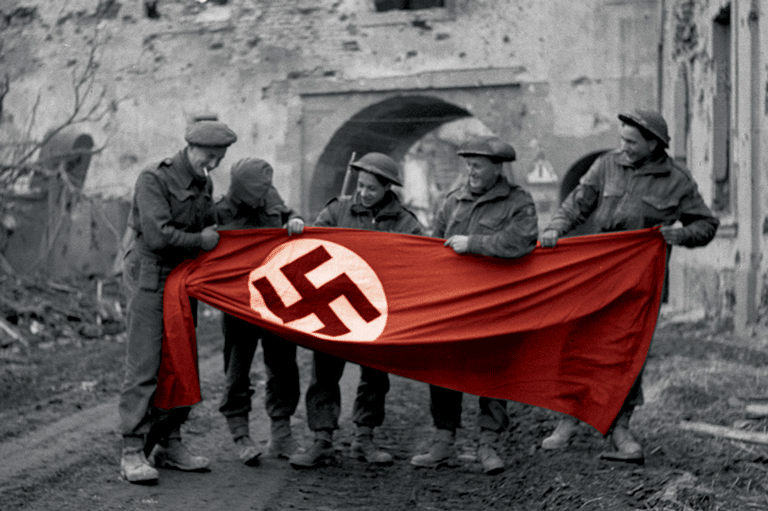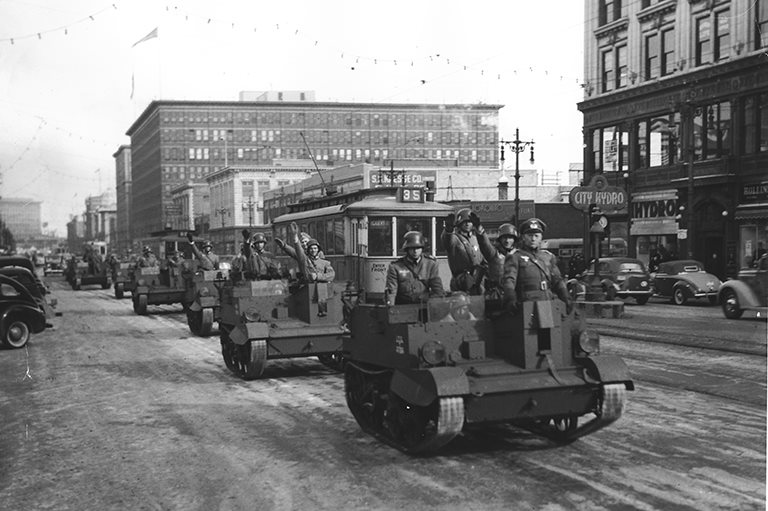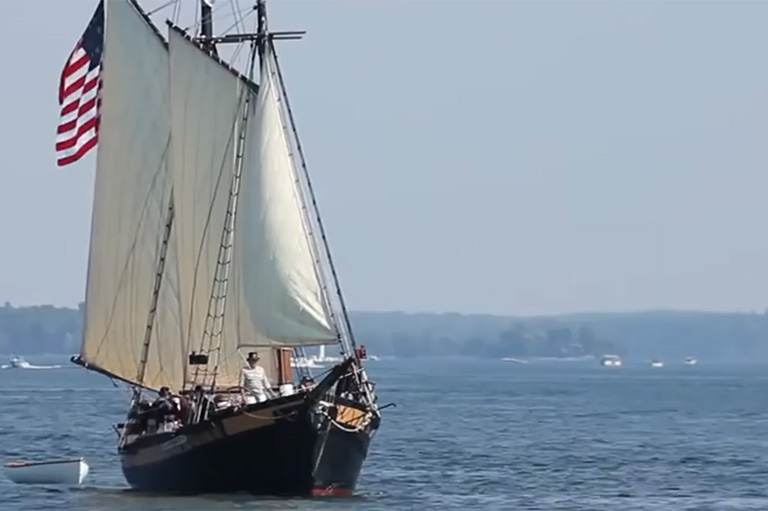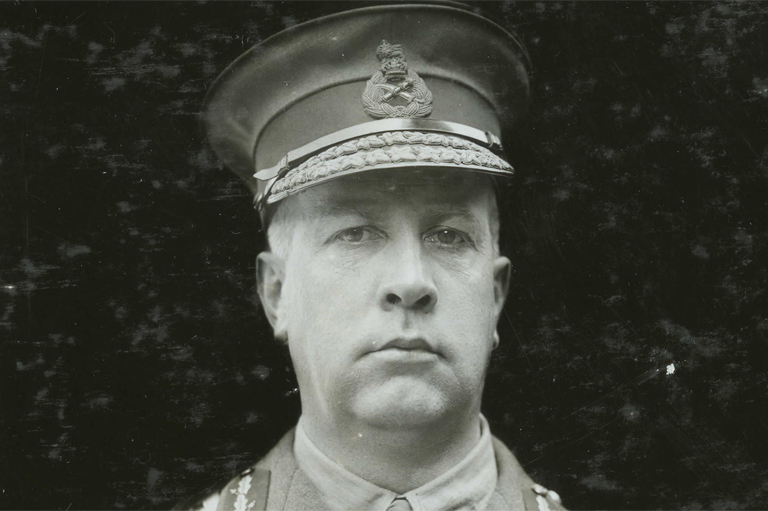Airborne Assault
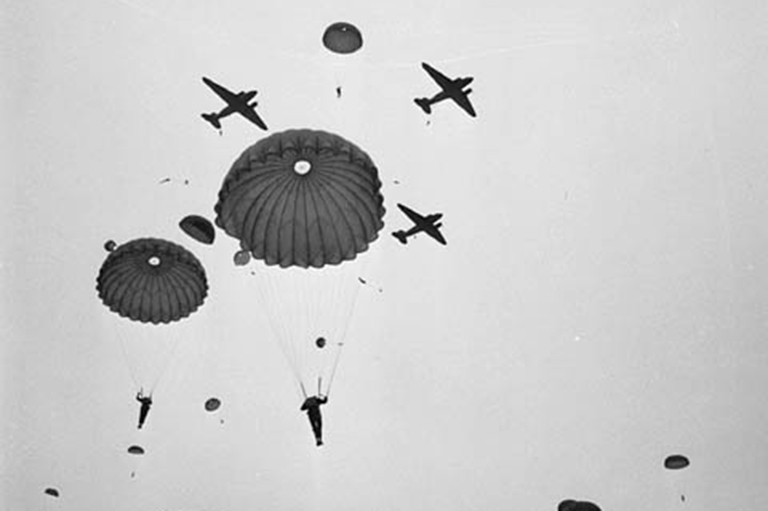
The skies were clear and calm on the morning of March 24, 1945, as Major Richard Hilborn stood at the exit door of his C-47 Dakota transport aircraft and watched his plane, and countless others, flying in V formations across the North Sea. The Preston, Ontario, native and about five hundred fellow members of the 1st Canadian Parachute Battalion belonged to the enormous Allied air armada called Operation Varsity that was about to make an authoritative final push into Germany to help end the Second World War.
The paratroopers were headed into an area defended by hardened German soldiers fighting to protect their homeland. But, after almost a year of combat experience in some of the war’s most gruelling conditions, Hilborn was confident in himself and in the men under his command. “We were now a battle trained, experienced battalion,” the major wrote roughly five decades later in his self-published autobiography It’s Been Fun. “I think we were finally as good as anyone in the business.”
The Canadian battalion was part of the 6th British Airborne Division, integrated into the division’s 3rd Parachute Brigade under the command of Brigadier James Hill. The Canadians had left England at 7:30 a.m. amid an armada launched from twenty-six different airfields that included more than 1,600 troop transport planes, 1,300 gliders, and nearly 900 escort fighters. The aircraft were poised to deliver approximately sixteen thousand American, British, and Canadian paratroopers — along with vehicles, equipment, and weapons — across the mighty Rhine River into western Germany.
In the days following the invasion eighty years ago, newspapers would claim that the line of aircraft leaving the coast of England was nearly 250 kilometres long and that it took more than an hour to pass over any given point. It was the largest airborne assault in history.
With 7 uniquely curated newsletters to choose from, we have something for everyone.
On the ground below, the Allies had swept across Western Europe following the successful D-Day invasion of June 6, 1944, liberating Paris in August and Antwerp, Belgium, in September 1944. In January 1945, the Allies repulsed a major German counteroffensive known as the Battle of the Bulge in the Ardennes region of Belgium and Luxembourg. The men of the 1st Canadian Parachute Battalion fought as ground troops in that battle before returning to England to regroup.
Then in February 1945, British Field Marshal Bernard Montgomery’s 21st Army Group — which included British, Canadian, and American divisions — launched a major offensive to push Hitler’s armies back toward the Rhine. The Germans retreated across the river, blowing up the bridges behind them, but Hitler still would not admit defeat. The Allies resolved to press their offensive across the Rhine and into the German heartland.
After nightfall on March 23, British, Canadian, and American ground troops began crossing the Rhine near the German city of Wesel in an action known as Operation Plunder. While artillery strikes and bombing runs weakened the German defensive positions, the ground troops used amphibious tracked landing craft and portable, prefabricated truss bridges known as Bailey bridges to cross the flowing water. Meanwhile, the airborne soldiers were tasked with parachuting directly into the German front lines on the east side of the river to engage the enemy in close-range combat.
Unlike D-Day, when parachutists dropped into occupied France under the cover of night, the Rhine drop was a daytime operation; the paratroopers would take advantage of the light to stay organized, reach their rendezvous points quickly, and overwhelm the Germans’ defensive positions.
Flying at an altitude of between 100 and 150 metres, the Canadians arrived at the drop zone near the towns of Hamminkeln and Wesel at 9:55 a.m. Green lights switched on inside the planes, signalling that it was time to jump, and Hilborn and the other Canadians hurled themselves into the air.
It took about seventeen seconds for each paratrooper to reach the ground, making them prime targets for anti-aircraft and machine-gun fire. “What are all these bees doing at 300, 400 feet in the month of March?” Private Morris Zakaluk thought during his descent to the battlefield, before he realized that the buzzing was actually the sound of enemy bullets zipping by him.
Twenty-three Canadians were killed and forty were wounded during the assault, some while still in mid-air. Two more were captured. The Canadian battalion’s commander, Lieutenant-Colonel Jevon “Jeff” Nicklin, was among the dead. His parachute had become entangled in a tree above a German gun crew, and he had seven bullet holes in his pelvis when his body was found. Following Nicklin’s death, Lieutenant-Colonel Fraser Eadie was named battalion commander, while Hilborn was promoted to second-in-command.
For those who made it safely to the ground, the battle had just begun. The Canadians were ordered to seize the forest along the south-western half of the drop zone, secure nearby farm buildings and houses, and prepare for German counterattacks. The battalion completed its objectives within hours, as German troops either retreated or surrendered on the battlefield. “It really was flat-out fighting until about noon,” Hilborn told the Canadian Press a few days later, while Eadie described it as “two hours of real killing.”
One Canadian parachutist, medical orderly Corporal Frederick Topham, earned the Victoria Cross for heroism that day. After seeing two other medical orderlies killed while trying to treat an injured soldier, the twenty-seven-year-old Topham raced across an open field, administered first aid under intense gunfire, then carried the soldier to safety while disregarding his own injury — a shot through the nose. Later that day he pulled three men from a burning armoured personnel carrier.
After the fighting ended, Hilborn was among a group of men who volunteered to recover Nicklin’s body, which they wrapped in his parachute. “To me he was a fine leader, a great friend, and I still regret that I was denied the opportunity of seeing more of him after the war,” Hilborn wrote in his autobiography. In an interview with Canada’s History, Hilborn’s son Michael said the major had “insisted on going” to recover Nicklin. “I bet it was tough. He was very fond of him.”
Total casualties for the paratroopers that morning were high. Of the 7,200 members of the 6th British Airborne, about 1,400 were killed or wounded. Another 1,300 of the 9,600 American 17th Airborne were killed or wounded. The assault over the Rhine was the last major airborne operation of the Second World War. Having won the battle, the Canadians and British enjoyed a brief respite to recover and regroup while they awaited new marching orders.
Advertisement
Meanwhile, on the eastern front, the Russian army was advancing relentlessly. Having re-entered Kyiv, Ukraine, in November 1943, the Soviets marched into Poland, Lithuania, Romania, Bulgaria, Hungary, and Finland in 1944. By January 1945 they had taken the Polish capital of Warsaw and had their sights set on winning the race to Berlin. In February 1945, with victory over Germany growing more likely, American President Franklin D. Roosevelt, British Prime Minister Winston Churchill, and Soviet leader Joseph Stalin met in Yalta on the Crimean Peninsula to discuss the division of post-war Germany into American, British, French, and Soviet zones.
Although the German Army’s defeats in the east meant good news for the Allies, Churchill, Roosevelt, and Supreme Commander of Allied Forces in Europe Dwight Eisenhower worried that the territory occupied by the Russians would fall under Soviet communist dictatorship after the war. This concern applied, among other places, to German-occupied Denmark. The British and Americans decided to push east as quickly as possible, not only to cut off the forces of German Field Marshal Ernst Busch in the north but also to act as a doorstop against the Russian advance through northern Germany.
The key objective was the German port city of Wismar, 250 kilometres northwest of Berlin on the Baltic Sea. Strategically positioned along the northern coastline, the picturesque medieval town of red-brick buildings and cobblestone walkways held such tactical importance that the Nazis had expanded its port and shipbuilding facilities throughout the war. Soviet Marshal Konstantin Rokossovsky, one of the Red Army’s most prominent commanders, was moving toward Wismar from the east with orders to secure the city and continue all the way to the Danish border.
So on March 26, 1945, the Canadians and their British compatriots in the 6th Airborne Division were given new marching orders — a five-hundred-kilometre trek across Germany to secure Wismar before the Russians. “The drive clearly a high-level political decision at the Eisenhower and Churchill level,” says Terry Copp, a leading scholar of Canadian military history and director emeritus of the Laurier Centre for the Study of Canada. “If you look at the map and you’re trying to seal off Denmark, it pretty much has to be at Wismar.”
The toll of Operation Varsity, Copp says, had convinced even the most ardent airborne advocates that they should avoid another parachute operation. Instead, the paratroopers mounted the tanks of the British Royal Scots Greys regiment and prepared to travel overland to the Baltic coast.
Save as much as 40% off the cover price! 4 issues per year as low as $29.95. Available in print and digital. Tariff-exempt!
The trek to Wismar promised to be gruelling for the Canadians. But they had been prepared by years of rigorous training — at Fort Benning (now Fort Moore), Georgia, starting in 1942; at Canadian training base Shilo in Manitoba beginning in April 1943; and at Carter Barracks in Bulford, England. Their training went beyond the usual boot camp exercises and sought to shape the men into an elite group of soldiers plucked from the very best volunteers that the country could muster.
Selection standards were high, with volunteers scored from “A” (most desirable) to “E” (least desirable). Only those who achieved an A rating were allowed to begin airborne training, which meant roughly half of all volunteers were rejected. Aggressiveness, emotional stability, high motivation, and self-reliance were prerequisites for an A rating, as well as a high standard of mental, physical, and psychological fitness. Of those who qualified, about a third failed out of the parachute program — some for their inability to complete the physical or mental tests, others because of injuries.
Lieutenant-Colonel D.H. Taylor, commander of A-35 Canadian Parachute Training Centre in Shilo, believed the bulk of the training should be focused on the goal of creating “good, tough soldiers first; jumpers second.” Under Taylor, the men endured an eight-week ground-training course before they ever saw a parachute. Only those candidates who passed ground training were eligible to begin the three-week parachute course.
Other testing included a dreaded eighty-kilometre march that had to be done in less than twenty-four hours while wearing full battle dress. Weapons training and accuracy were also given high priority.
Taylor once observed, “the toughness required of a parachutist cannot be overestimated. Men can’t quit road marches because they’re tired.” His remark proved prophetic as the Canadians departed for Wismar. The month-long trek ahead would become a relentless cycle of riding atop tanks and in Jeeps, commandeering enemy vehicles, and old-fashioned marching. Michael Hilborn said his father — an avid sportsman who enjoyed boxing, hockey, and hunting in his youth — was up to the task. “Most of them, actually, these guys were real athletes.”
Their advance through Germany was so rapid that they ran into an unexpected problem: what to do with all the German soldiers trying to surrender? By this time, many of the frontline troops realized that the war was lost, and they preferred to surrender to the Canadians and British, rather than take their chances in a Russian prisoner-of-war camp. By April 10, the Canadian Press reported that the paratroopers had captured more than one thousand enemy combatants and “no longer bother to send prisoners back escorted, they merely indicate the direction and say ‘go.’”
The Canadian Press also reported that the maps sent from headquarters to aid in the paratroopers’ movements “usually arrive after the areas have been taken.” One commander reportedly relied on a high-school atlas, recovered shortly after the jump over the Rhine, to help plan for battle. The Allied resupply lines also had trouble keeping pace with the paratroopers. To stay warm and augment their firepower, the Canadians could sometimes be seen wearing German sheepskin jackets or carrying German guns, like the iconic MP 40 submachine gun or Luger pistol.
But not every German soldier was ready to surrender. On April 8, the paratroopers met a defiant tank and infantry unit near the town of Ricklingen and came under artillery and machine-gun fire. The battalion war diary recorded four casualties. A week later, an enemy aircraft dropped a bomb on B Company, killing two men and wounding two others.
Some of the Canadians witnessed the atrocity of the Nazi regime when their company arrived at the Bergen-Belsen concentration camp shortly after it was liberated on April 15. An estimated fifty thousand people died at the camp from 1943 to 1945, including the diarist Anne Frank, and it housed more than sixty thousand prisoners when it was freed. While Eadie and some others entered the camp to survey the scene and help the prisoners, Hilborn chose not to. His ninety-eight-year-old widow, Laurette Hilborn-Pond, said in an interview that he could sense the horrors the camp contained. “He said he didn’t need to go. [He said,] ‘I knew what was in there.’”
By the time the paratroopers crossed the Elbe River, about 150 kilometres southwest of Wismar, on April 30, they began encountering long rows of German soldiers and civilians — many of them fleeing the advancing Russians. “They reasoned that the more territory we occupied, the less the Russians could occupy,” the war diary entry for May 2 states. “Thousands of German troops lined the roads and crowded the villages, some even cheering us on, though most were a despondent-looking mob.”
The battalion rolled into Wismar that afternoon. Just two hours after their arrival, a Russian officer arrived by jeep. According to the battalion diary, the officer was “quite put out to find us sitting on what was the Russians’ ultimate objective.”
Advertisement
Hilborn was named chief liaison officer with the Russians in Wismar, and he enlisted the help of several battalion members from families of Russian immigrants who could speak the language. The battalion diary and Hilborn’s own autobiography suggest the gears of this early diplomacy were greased with plenty of alcohol. “We soon learned we had to down drinks Russian style. None of this sipping of drinks as is our western habit,” Hilborn wrote of one meeting. “It was strictly ‘down the hatch’ with the whole drink,” and the glass was immediately refilled.By that time, Hilborn was confident that the war was all but over. The Allies placed the covers on their artillery and faced them westward to await orders to return home. But the Russians were wary of the Brits and Canadians: They set up a roadblock, restricting access to the area they occupied near the town. The Russian artillery also remained pointed westward, Hilborn wrote.
Though tensions simmered, the weather remained warm and clear. No longer ducking German sniper fire or dodging mortars, the “main problem was how to keep the troops contented and busy” as they awaited the official end of the war, the battalion war diary reported on May 6. Softball, football, and rugby helped pass the time, as did sailing and swimming in the harbour. They were under orders not to fraternize with local civilians or Soviet soldiers.
The morning of May 7 brought news of Germany’s unconditional surrender. Gin, whisky, vodka, wine, and schnapps flowed in Wismar as the Canadians celebrated the end of hostilities in Europe. Even the war diary entry for the day reported “everybody had a grand time acquiring the inevitable hangover.” The next day, May 8, was declared Victory in Europe (VE) Day by Churchill, and the Canadian and British troops held joint celebrations with the Russians.
The Canadians remained in Wismar for nearly two more weeks, holding a victory march on May 11 and a memorial service on May 13. Finally, on May 19, the Canadians were transported to a nearby airfield for return to England; the last of the British troops followed by July 1. Returning to Canada that summer aboard the former French luxury liner Île de France, the paratroopers were welcomed as heroes by parades in Halifax and Toronto. Following Japan’s surrender on September 2, the unit was officially disbanded on September 30, 1945.
In the end, the Canadian paratroopers’ rush to Wismar didn’t stop the city from being shut behind the Iron Curtain. According to the agreements drawn up during the Yalta Conference in February, Wismar fell about sixty kilometres inside the Soviet zone of occupation. It remained part of communist East Germany until 1990.
Still, the Canadians had done their job to limit the Soviet advance westward towards Denmark. After enduring five years of brutal Nazi occupation, the country avoided falling under Stalin’s thumb. The only exception was the offshore island of Bornholm, which the Soviet army occupied from May 10, 1945, to April 5, 1946.
The experience of the Second World War stuck with Hilborn and other battalion members forever. Michael Hilborn said it was decades before his father could talk with him about the conflict, and Laurette Hilborn-Pond can still recall talks she had with her late husband near the end of his life about his wartime experience. “It wasn’t easy to kill people,” she said, with a long pause. “We had long conversations about that. I like to feel that I really helped him, and he could talk to me about it.”
We hope you will help us continue to share fascinating stories about Canada’s past.
We highlight our nation’s diverse past by telling stories that illuminate the people, places, and events that unite us as Canadians, and by making those stories accessible to everyone through our free online content.
Canada’s History is a registered charity that depends on contributions from readers like you to share inspiring and informative stories with students and citizens of all ages — award-winning stories written by Canada’s top historians, authors, journalists, and history enthusiasts.
Any amount helps, or better yet, start a monthly donation today. Your support makes all the difference. Thank you!

